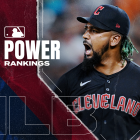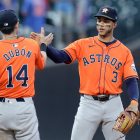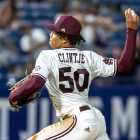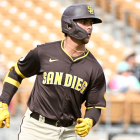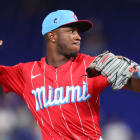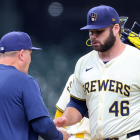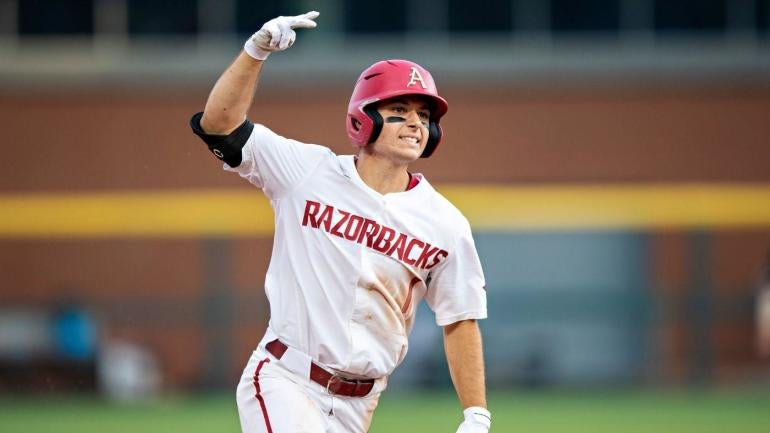
Hear that? 'Tis the approaching hoofbeats of This, Our Baseball.
No, it's not baseball at the highest level, since the owner-implemented lockout continues to keep Major League Baseball on hold. Rather, it's the 2022 college baseball season of which we speak. It gets underway soon, which means it's time to preview that particular season to come.
Mississippi State enters the 2022 season as the reigning national champion in Division I, and as we'll soon see they have plausible designs on becoming the first repeat College World Series winner since South Carolina in 2010-11. Now let's get to previewin'.
Composite 2022 preseason rankings
To get started, let's take a look at some composite rankings. What we've done is taken each of the six major preseason polls (Baseball America, Perfect Game, USA Today coaches' poll, D1Baseball.com, Collegiate Baseball Magazine, and the National Collegiate Baseball Writers' Association) and assigned "poll points" to each team ranked in the top 25 of each poll. No. 1-ranked teams get 25 points, No. 2-ranked teams get 24 points, all the way down to the No. 25-ranked teams, which get one point. We add all the points up -- across, again, all six major polls -- and arrive at our composite preseason rankings.
Here's a look at what comes out of the wash for 2022:
Rank | Team | Poll points | Conference | 2021 record |
1. | Texas | 149 | Big 12 | 50-17 |
2. | Vanderbilt | 144 | SEC | 49-18 |
3. | Mississippi State | 128 | SEC | 50-18 |
4. | Stanford | 125 | Pac-12 | 39-17 |
5. | LSU | 116 | SEC | 38-25 |
6. | Arkansas | 109 | SEC | 50-13 |
7. | Notre Dame | 104 | ACC | 34-13 |
8. | Ole Miss | 101 | SEC | 45-22 |
9. | Florida | 95 | SEC | 38-22 |
10. | Oklahoma State | 86 | Big 12 | 36-19 |
11. | East Carolina | 83 | American Athletic | 44-17 |
T-12. | Florida State | 77 | ACC | 31-24 |
T-12. | NC State | 77 | ACC | 37-19 |
T-12. | Texas Tech | 77 | Big 12 | 39-17 |
15. | Arizona | 67 | Pac-12 | 45-18 |
16. | TCU | 54 | Big 12 | 41-19 |
17. | UC-Irvine | 46 | Big West | 43-18 |
18. | Georgia Tech | 45 | ACC | 31-25 |
19. | Tennessee | 41 | SEC | 50-18 |
T-20. | Oregon State | 37 | Pac-12 | 37-24 |
T-20. | Virginia | 37 | ACC | 29-23 |
22. | Georgia | 35 | SEC | 31-25 |
23. | UCLA | 28 | Pac-12 | 37-20 |
24. | Miami-FL | 13 | ACC | 33-21 |
25. | Oregon | 12 | Pac-12 | 39-16 |
Also receiving poll points: Dallas Baptist (11), Louisiana Tech (11), Nebraska (11), Central Michigan (10), UC-Santa Barbara (9), Duke (4), Long Beach St. (4), Old Dominion (2), Liberty (1), North Carolina (1)
Texas, the consensus top team going into the 2022 season, notches 149 out of a possible 150 poll points, which means they finished first in five polls and second in the other. Coming off a 2021 season in which they went 50-17 in the tough Big 12 and made the College World Series, the Longhorns in 2022 feature what may be the best pitching staff in the country and an elite power hitter in first baseman Ivan Melendez.
Last year's CWS runner-up Vanderbilt bid adieu to tandem aces Kumar Rocker and Jack Leiter, but a veteran lineup and one of the best recruiting classes in the country means they won't miss a beat. As for the reigning champs, Mississippi State suffered notable losses in the rotation, but they return a great deal of experience and firepower in the lineup. As well, the Bulldogs' team defense should again be a pronounced strength.
The most divisive team in the rankings might be Virginia. Baseball America is by far the most bullish on the Cavaliers, as they have them ranked fifth. Two polls, however, left Virginia out of the top 25 entirely. Elsewhere, LSU's 2022 season will be one to watch under first-year head coach Jay Johnson, who last year guided Arizona to a CWS berth. LSU is coming off a 2021 season in which they posted a losing record in SEC play, and they haven't made it to Omaha since 2017 (a drought by LSU standards). They'll be stronger this season thanks largely to what should be perhaps the best offense in the country. Given the usual expectations in Baton Rouge, nothing short of the 19th CWS berth in program history will suffice.
Conference rankings
Let's widen our scope a bit and put together some preseason conference rankings by adding up all the poll points conference by conference (we'll also include the "others receiving poll points" teams in our tabulations). Looky here:
Conference | 2022 preseason poll points |
SEC | 769 |
Big 12 | 366 |
ACC | 358 |
Pac-12 | 269 |
American Athletic | 83 |
Big West | 59 |
Conference USA | 13 |
Big Ten, Missouri Valley | 11 |
MAC | 10 |
Atlantic Sun | 1 |
As is usually the case, the SEC profiles as the dominant conference once again. The SEC boasts six of the top 10 teams in the composite rankings, and overall eight of the conference's 14 teams cracked the top 25. That's fully in keeping with recent history, as the SEC has claimed seven of the last 12 national championships. The SEC placed three teams in the 2021 College World Series, and the Mississippi State-Vanderbilt final was an intra-conference affair. Multiple SEC teams have made the eight-team College World Series in each of the last four seasons (not counting 2020, in which the CWS was canceled because of COVID-19).
As is typically the case, you see a significant drop-off in conference depth after the big four (SEC, ACC, Big 12, and Pac-10). In terms of building programs, baseball is a tough sport for cold-weather conferences, which explains why the Big Ten, unlike in football and basketball, isn't among the giants and hasn't been for a very long time.
Key dates
A brief walking tour of the college baseball calendar for 2022? We aim to please.
- Feb. 18: No. 2 Vanderbilt opens the season by hosting No. 10 Oklahoma State for a three-game series in Nashville.
- Feb. 20: No. 12 Texas Tech faces No. 15 Arizona as part of the State Farm College Baseball Showdown in Arlington, Tex.
- Feb. 26: In the second weekend of the regular season, No. 6 Stanford faces No. 4 Arkansas in Round Rock, Tex.
- March 5: Likely the biggest non-conference game of the regular season pits No. 1 Texas against No. 5 LSU in Houston's Minute Maid Park.
- March 8: Defending national champs No. 3 Mississippi State begins a two-game set against No. 12 Texas Tech in Biloxi, Miss.
- March 11: Pac-12 conference play begins.
- March 18: SEC, ACC, and Big 12 conference play begins.
- May 24: The SEC Tournament begins in Hoover, Ala. On this same day, the ACC Tournament begins in Charlotte.
- May 25: The Big 12 Tournament begins in Arlington, Tex. Pac-12 Baseball Tournament begins in Scottsdale, Ariz.
- May 31: It's Selection Tuesday, as the NCAA Tournament field of 64 is announced.
- June 3: The NCAA Regionals begin and run through June 6 (see below for an explanation on how the NCAA Baseball Tournament works).
- June 10: The NCAA Super Regionals begin.
- June 17: The 2022 College World Series begins in Omaha.
- June 25: The best-of-three CWS finals begins and concludes on either June 26 or June 27 with the crowning of the 2022 national champion.
How the NCAA Tournament and College World Series work
Given that college baseball isn't as widely followed as the football and basketball collegiate variants, perhaps a brief postseason explainer is in order. Here's how it all works, in bullet-point format for today's harried sales professional ...
- The first round of play is known as the regional, and it's a round-robin, double-elimination format featuring four teams. Each of the 16 one-seeds hosts its respective regional, when possible. Only one team out of four survives each regional.
- The winner of each regional advances to the super regional, which is a best-of-three series between two regional winnes.
- The winner of each super regional -- eight teams in all -- advances to the College World Series in Omaha.
- The College World Series is a double-elimination format until the final two teams are left standing. At that point, the slates are wiped clean, and it's a best-of-three series to determine the national champion.
- The field of 64 also includes eight national national seeds, which you may consider the pre-tourney favorites to reach Omaha. National seeds get to host super regionals should they advance that far.
So, yes, it's quite different from the more familiar March Madness format, but it typically entails similar levels of, you know, madness.
Players to watch
Top draft-eligible D1 collegians -- i.e., juniors, seniors, or sophomores who will turn 21 before the draft -- include James Madison outfielder Chase DeLauter, Cal Poly shortstop Brooks Lee, Texas Tech infielder Jace Jung, Stanford outfielder Brock Jones, LSU infielder Jacob Berry (a transfer from Arizona), and Arkansas second baseman Robert Moore (the son of Royals operator Dayton Moore). It's position-player heavy because so many draft-eligible starting pitchers have suffered serious injuries this offseason. Anyhow, this is of course a partial listing, and the season to come could drastically change draft stock up and down the board.
Our own R.J. Anderson has a more in-depth look at the 2022 draft class.
A bit of history
In conclusion, let's run down all the past college baseball national champions and runners-up:
| YEAR | NATIONAL CHAMPION | RUNNER-UP |
|---|---|---|
| 2021 | Mississippi State (50-18) | Vanderbilt |
| 2020 | None (COVID-19) | None |
| 2019 | Vanderbilt (59-12) | Michigan |
| 2018 | Oregon State (55-12-1) | Arkansas |
| 2017 | Florida (52-19) | LSU |
| 2016 | Coastal Carolina (55-18) | Arizona |
| 2015 | Virginia (44-24) | Vanderbilt |
| 2014 | Vanderbilt (51-21) | Virginia |
| 2013 | UCLA (49-17) | Mississippi State |
| 2012 | Arizona (48-17) | South Carolina |
| 2011 | South Carolina (55-14) | Florida |
| 2010 | South Carolina (54-16) | UCLA |
| 2009 | LSU (56-17) | Texas |
| 2008 | Fresno State (47-31) | Georgia |
| 2007 | Oregon State (49-18) | North Carolina |
| 2006 | Oregon State (50-16) | North Carolina |
| 2005 | Texas (56-16) | Florida |
| 2004 | Cal State Fullerton (47-22) | Texas |
| 2003 | Rice (58-12) | Stanford |
| 2002 | Texas (57-15) | South Carolina |
| 2001 | Miami (Fla.) (53-12) | Stanford |
| 2000 | LSU (52-17) | Stanford |
| 1999 | Miami (Fla.) (50-13) | Florida State |
| 1998 | Southern California (49-17) | Arizona State |
| 1997 | LSU (57-13) | Alabama |
| 1996 | LSU (52-15) | Miami (Fla.) |
| 1995 | Cal State Fullerton (57-9) | Southern California |
| 1994 | Oklahoma (50-17) | Georgia Tech |
| 1993 | LSU (53-17-1) | Wichita State |
| 1992 | Pepperdine | Cal State Fullerton |
| 1991 | LSU (55-18) | Wichita State |
| 1990 | Georgia (52-19) | Oklahoma State |
| 1989 | Wichita State (68-16) | Texas |
| 1988 | Stanford (46-23) | Arizona State |
| 1987 | Stanford (53-17) | Oklahoma State |
| 1986 | Arizona (49-19) | Florida State |
| 1985 | Miami (Fla.) (64-16) | Texas |
| 1984 | Cal State Fullerton (66-20) | Texas |
| 1983 | Texas (66-14) | Alabama |
| 1982 | Miami (Fla.) (55-17-1) | Wichita State |
| 1981 | Arizona State (55-13) | Oklahoma State |
| 1980 | Arizona (45-21-1) | Hawaii |
| 1979 | Cal State Fullerton (60-14-1) | Arkansas |
| 1978 | Southern California (54-9) | Arizona State |
| 1977 | Arizona State (57-12) | South Carolina |
| 1976 | Arizona (56-17) | Eastern Michigan |
| 1975 | Texas (59-6) | South Carolina |
| 1974 | Southern California (50-20) | Miami (Fla.) |
| 1973 | Southern California (51-11) | Arizona State |
| 1972 | Southern California (47-13-1) | Arizona State |
| 1971 | Southern California (46-11) | Southern Illinois |
| 1970 | Southern California (45-13) | Florida State |
| 1969 | Arizona State (56-11) | Tulsa |
| 1968 | Southern California (43-12-1) | Southern Illinois |
| 1967 | Arizona State (53-12) | Houston |
| 1966 | Ohio State (27-6-1) | Oklahoma State |
| 1965 | Arizona State (54-8) | Ohio State |
| 1964 | Minnesota (31-12) | Missouri |
| 1963 | Southern California (35-10) | Arizona |
| 1962 | Michigan (34-15) | Santa Clara |
| 1961 | Southern California (36-7) | Oklahoma State |
| 1960 | Minnesota (34-7-1) | Southern California |
| 1959 | Oklahoma State (27-5) | Arizona |
| 1958 | Southern California (29-3) | Missouri |
| 1957 | California (35-10) | Penn State |
| 1956 | Minnesota (37-9) | Arizona |
| 1955 | Wake Forest (29-7) | Western Michigan |
| 1954 | Missouri (22-4) | Rollins |
| 1953 | Michigan (21-9) | Texas |
| 1952 | Holy Cross (21-3) | Missouri |
| 1951 | Oklahoma (19-9) | Tennessee |
| 1950 | Texas (27-6) | Washington State |
| 1949 | Texas (23-7) | Wake Forest |
| 1948 | Southern California (26-4) | Yale |
| 1947 | California (31-10) | Yale |
Now go forth and enjoy the actual, real-life, on-field baseball.










